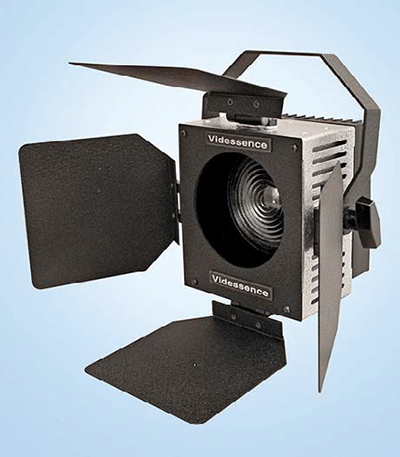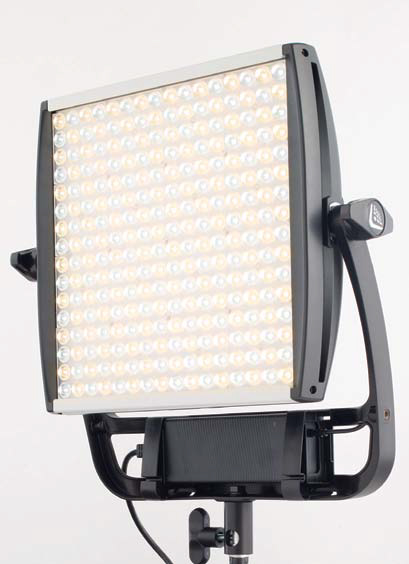Advances in Lighting Add More Versatility
SEATTLE—When LED lighting fixtures hit the video and film production scene a decade ago, their advantages in areas like low-power consumption and heat generation made them an instant hit. In the years since then, advances in the LEDs themselves, in the phosphors that radiate the various colors, and in other technologies such as optics have allowed lighting equipment manufacturers to create new generations of lighting fixtures.
The color output of LED fixtures is a much-discussed characteristic of lights today. “I think the customers are a lot more savvy,” said Charlie Collias, senior vice president of worldwide sales for Zylight in Los Angeles. “They’re looking for LEDs with high CRI, color rendering index values.”

Videssence Little Vid Fresnel Collias added that high CRI is particularly important on a set with mixed lighting equipment. “It’s important in the overall look of the show, especially when you mix LEDs and other light sources together.”
Zylight’s F8 Fresnel LED fixture touts a special blend of Quantum nanoparticles with traditional phosphor technology. “It provides better spectral control, higher efficiency, higher color rendering, and the color pallet matches other lights on the set.”
A ‘PERFECT STORM’
Litepanels Senior Product Manager Ali Ahmadi said changing technologies have led the company to redesign its flagship product.
“We saw this perfect storm at the horizon, and so we pushed into this opportunity with our new Astra,” he said. “We’re taking the concept of a 1x1 panel and completely redefining it from the bottom up. We’re using new LED and phosphor technology, and basic advances in optics, making high-quality optics accessible at an affordable price-point.”
The Astra provides an even softer light, and four times the intensity of a traditional 1x1 panel. “We’ve created a completely different optical system with the new generation LEDs and the lenses that sit in front of them,” he said. “That basically creates an optical engine that drives that light output. A lot of light comes out the front, and then it mixes immediately outside the fixture, which is how we’re able to create that soft look.”
Get the TV Tech Newsletter
The professional video industry's #1 source for news, trends and product and tech information. Sign up below.
While LEDs generate a small fraction of the heat of tungsten or HMI bulbs, there still is heat to deal with. Some LED fixture manufacturers install the quietest fans they can find. Videsssence developed a new technology that allows them to build their LED fixtures without a fan, an important detail on sets where extraneous noise is a problem, according to Gary Thomas, national sales manager for the El Monte, Calif.-based company. “They operate cool without a fan,” he said.
For field production, Videssence has introduced its Little Vid Fresnel series, 50-Watt fixtures available with a focusable or stationary Fresnel lens. A new DC adapter is on the way for the Little Vids, and an optional module can provide DMX control. “It’s very lightweight and can go on a jib arm or light stand. No fans and it draws half an amp of electricity.”
REMOTE PHOSPHOR
Where traditional LED lighting fixtures have the phosphor layer applied to the LED bulbs themselves, a recent approach has been to separate the phosphor layer from the LEDs, a technology called “remote phosphor.” The phosphor layer in such fixtures resides on a translucent panel in front of the LED bulbs.
“What I think remote phosphor does very well is that it’s very bright, very good color quality, and a very broad, soft light source in terms of lighting characteristics,” said Rich Pierceall, CEO of Cineo Lighting in El Granada, Calif. “Our first product was called the HS, which has the output of a 4K traditional fixture. It’s a great replacement for soft sources for news sets, for talk show sets, and we’re everywhere now.”

Litepanels Astra Using the same custom formulation of phosphors developed for the HS fixtures, Cineo is now introducing a portable line of remote phosphor fixtures. “They give the same color quality, the same softness, and they match because we use the same phosphor formulation,” Pierceall said.
Ken Fisher, director of marketing for BBS Lighting, pointed out an additional advantage in separating the phosphor layer from the LED bulbs. “With legacy LED technology, you have one small little drop of phosphor applied to the bulb, where with a phosphor panel, the entire front panel is coated with phosphors.” The panel inherently diffuses the output from the lighting fixture.
The fact that the phosphor panels on the BBS Area 48 fixtures can be interchanged is also a benefit, he said. “With the same fixture you could go from a very high output tungsten color balance fixture to a very high output daylight fixture in about 10 seconds,” Fisher said. “Similarly you could go from a green screen to a blue screen, you just change it out to the appropriate panel. So you have one core fixture that is very flexible.”
The separation of the phosphor layer from LED bulbs also keeps the LED’s heat from damaging the phosphors themselves. “It allows you to put more power behind the LED without adversely affecting the phosphors themselves,” Fisher added.
KEEPING PACE
In addition to changes in the technologies built into the lighting fixtures themselves, other changes in imaging have affected professional lighting equipment.
“I think the biggest challenge facing lighting manufacturers is the fact that not only have we seen a shift in the evolution of lighting technologies, but it’s come together with the evolution of imaging technologies,” said Frieder Hochheim, president of Kino Flo in Burbank, Calif. “The color points we used to use in choosing and constructing a color spectrum [from a light] was provided by Fuji and Kodak, manufacturers of film. For competitive reasons, that same data is not forthcoming from camera makers.”
To close this information gap, Hochheim’s company developed tools to divine the photographic rendering index from high end cinema cameras. “What our research has shown is that cameras are divergent enough that not one particular color point is actually perfect for everything,” he said. “There’s a degree of variation between cameras.”
Kino Flo’s Celeb is a result of that research, accoding to Hochheim. “The rapid acceptance of our Celeb fixture is a reflection of the fact we have done our homework, and it’s harmonizing well the high-end cinema cameras,” he said.
Hive Lighting in Los Angeles, has taken a different technology altogether by utilizing plasma bulbs instead of LEDs.
Jon Miller, Hive’s CTO says the company initially built spotlights which takes advantage of plasma’s high output, long throw lighting with low power draw. “But we also saw a space for a sort of ‘broad lighting,’ so our newest product out is our flood light, a 100-degree single-source flood,” he said. “You can use it where you would use your LED panels or larger fluorescent units, but unlike those it’s very easy to cut and shape.”
While Hive’s plasma light operates in the daylight color temperature range, it has just introduced a variable color temperature dial. “It’s a daylight dial that allows you to tune between 4600K all the way to 7000K,” Miller said. “It allows you to track the daylight throughout the day. It allows you to change your color temperature and takes real advantage of plasma’s full spectrum capability with a variation of color.”
You can expect no slowing down in the introduction of new technologies for lighting fixtures. One new product family to keep your eyes on are stadium lights. This week at the Texas Coaches Association Convention, Plano, Texas-based startup Sports Beams will introduce its Model 1200 Stadium Light. Relying on new high output LEDs, the 1200s can replace existing stadium lighting to provide the same or more illumination using a fraction of the energy.
These new lights bring a number of advantages of LED technology. Their ability to be instantly re-lit could avoid long lighting outages as was experienced at Super Bowl XLVII in 2013, and their dead-on daylight color temperature will blend well as afternoon turns to evening. They are flicker-free to avoid the strobing effect in extreme slow-motion replays, and are easily controlled via DMX networking.
